I discussed creating water effects and the construction of the dock and cargo transfer system on the waterfront of my layout in the July/August 2022 GAZETTE. In this issue, I’ll describe the various watercraft and the industries along the waterfront.
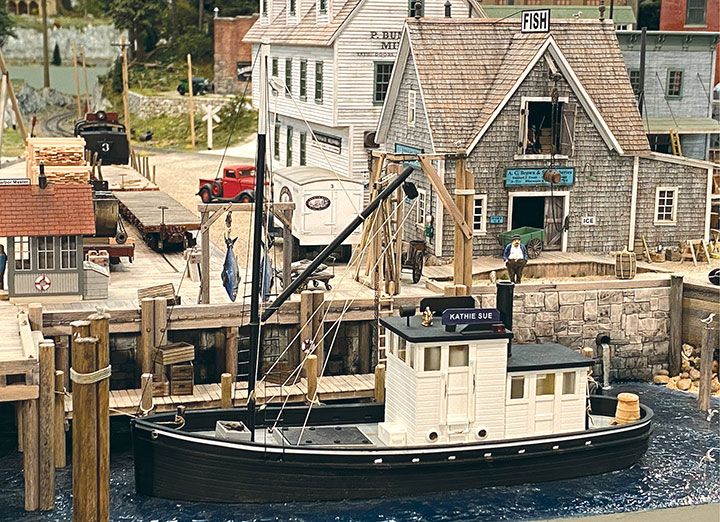
The Fleet
There are four boats alongside the pier; a steam powered, 82-foot, harbor tugboat, the Ventrice O.; a 48-foot cannery tender, the Kathie Sue; a nondescript, open-deck, cargo scow and a stern wheel logging tug, the Skookum. This is the story behind each of those craft.
I was not looking forward to becoming a boat builder. Modeling the compound curves on a ship’s hull seem intimidating. So, I farmed out the construction of my first boat to Spencer White, a professional boat builder that the late Paul Scoles had employed on several occasions. I was constructing a small fishery at one end of my pier and needed a fishing boat of sorts to tie up in front of the fish monger. Bill Roy of McKenzie Iron & Steel Co. offered a set of plans for a cannery tender and I sent them off to Spencer and asked for a waterline model of the same. Cannery tenders were used to shuttle between fishing boats and the coastal canneries.
While I was waiting for my tender to arrive, a friend offered me a Lindberg Models Kit #7412 of an ocean going, U. S. Coast Guard, Diesel tugboat. No scale was listed on the box, but it appeared to be close to HO. It was motorized and designed to float and operate on a pond. It was too modern looking for my 1930’s railroad, but the boat’s hull was timeless. After tossing around several conversion ideas, I settled on making it an old steam powered harbor tug. Back dating the tug was achieved by increasing the height of the smokestack and the pilot house. I replaced the plastic (steel) deck with a wood decking product that is available from both Bluejacket Shipcrafters Inc. and Micro-Mark. It represents teak wood decking with thin black seams between the boards. I use it a lot to represent wood flooring in many of my structures. I discarded all the superstructure above the main deck and rebuilt a new version out of styrene in 1:64 scale. I added a lifeboat and a davit for launching the boat. Of course, I was after a waterline model, so the lower part of the hull had to be sawed off. Interestingly, three excellent figures came with the kit, and they measured 6-feet in height in S scale, so they became part of the crew. The tug is an asset that belongs to the railroad company, so the Loon Lake Railway & Navigation Co. logo is prominently displayed on the smokestack in maritime tradition.
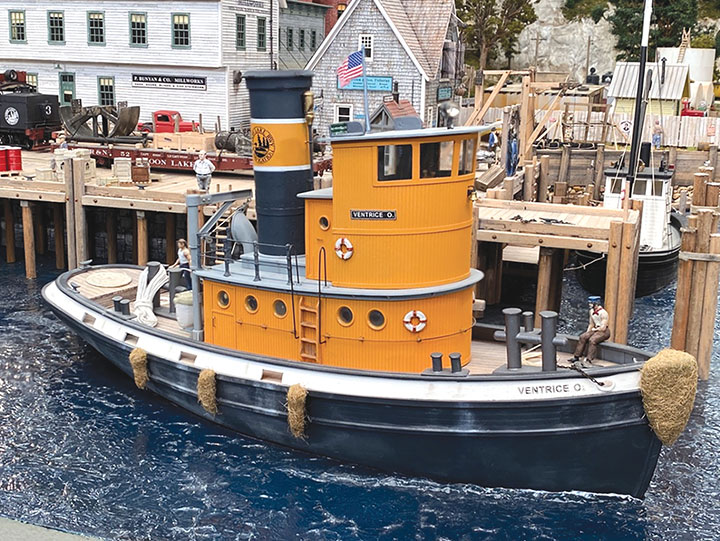
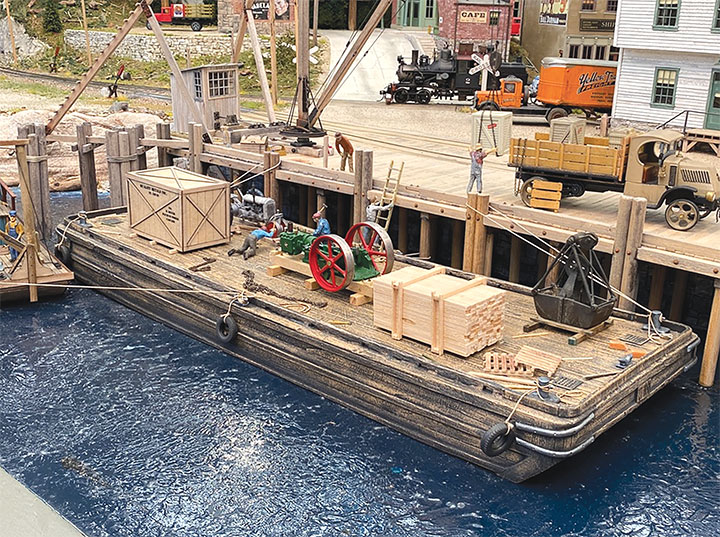
I now had two watercrafts but nothing to handle the cargo traffic which was the main reason for the dock complex. The perfect coastal freighter for this job appeared in a drawing by Robert D. Bailey in the July/August 2004 Gazette. It was the Steam Schooner S.S. Mariah. She was 135 feet long—as long as my entire dock! I settled for a wooden barge which worked out rather well
There are three vendors offering suitable barge kits: American Model Builders, Train Troll and Frenchman River Model Works. I chose the Frenchman River version. They market the same barge as an HO, S, or O scale model; thus, the length of the barge is determined by the scale of the layout it’s placed on. The model is a one-piece urethane casting and it worked out to be 68-feet in S scale. You simply add a scupper rail along the side and a few bollards and tie down castings and you’re done. The detail on the urethane barge casting is exquisite. All the dents and scrapes accumulated over years of service are rendered in the casting. The manufacturer recommends you spray the whole thing black, let it dry and then start rubbing it down with fine steel wool until you achieve the look you desire. Talk about simple. I loaded my barge with an AMB steam engine, a Crow River HO clamshell bucket, a pallet of lumber, crated machinery, a farm tractor, chains and lots of scrap dunnage. Then I tied it up to the pier. It sure beat building a boat from scratch
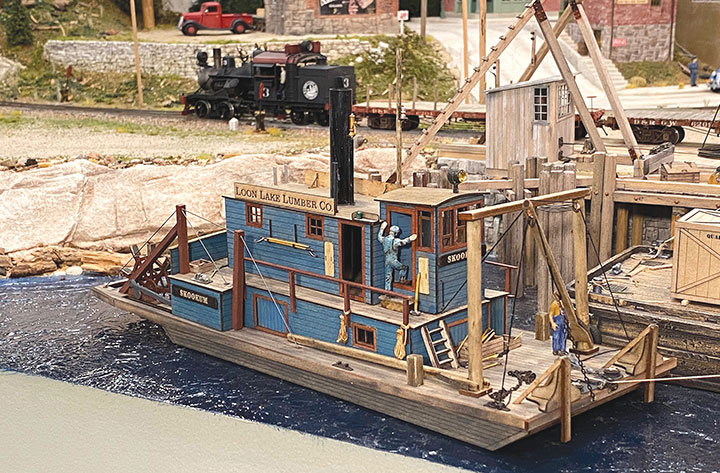
The latest addition to the fleet is the sternwheel, logging tug Skookum. This is a Train Troll kit and she’s a beauty. It follows no specific prototype. A friend, Bob Lenz, built this up for me and it’s a fascinating addition to the harbor scene. A boat of this type would be used to escort a log drive down the river, breaking up log jambs and such on the way to the mill or to a rail transfer point. She is tied up at the base of the stiff-legged derrick getting ready for a run upriver. By the late 1930s, a tug like this would have been a rare sight and very near the end of its useful service life. By the way, Train Troll produces a variety of boats in four different scales.
Wharf Side Industries
Currently there are just two industries wharf side—the Bunyan Millworks and Brown & Sons Fisheries. There is a large empty lot at the left end of the harbor that is programed to receive a boat works and a marine railway. It will probably resemble Sam Swanson’s lovely Reed Bros. Boatworks as described in the January/February 2017 GAZETTE. In the meantime, I have installed a tiny crab shack on the property. The crab shack is a Berkshire Valley kit that the owner cut for me in S scale
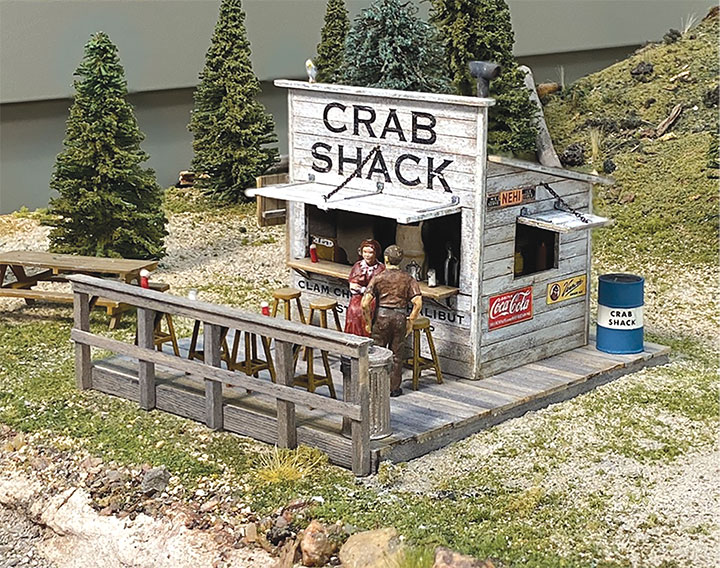
The Bunyan Millworks is the largest employer on the waterfront. It is an industry that would logically have sprung up in a timber town to take advantage of a ready supply of lumber and good proximity to truck, rail and ship transportation
The Millworks is really two buildings, the three-story, clapboard structure in front and the two-story, annex to the rear. The former is constructed of wood and the latter of styrene. The clapboards on this building are individual wood boards. The effect is very realistic as the boards abut the corner moldings and window frames, rather than the frame sitting atop the clapboard siding. I tape about eight 1x6 wood strips at a time to a piece of cardboard. I stain them first with a black/brown dye, then dry brush on a little color, and weather them sparingly with pastels. I then glue them to the milled, clapboard siding which acts as a sort of template.

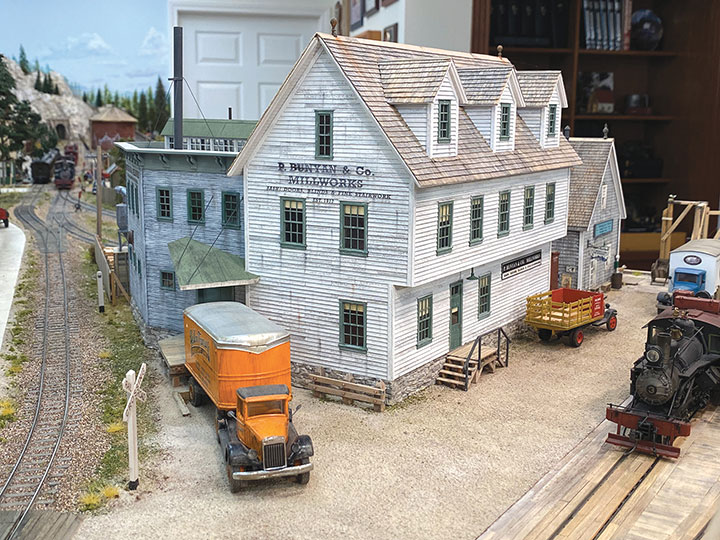
The fenced-in yard behind the Millworks sports a dust collector and stacks of air-dried lumber. The loading dock is filled with crated windows and doors awaiting the next empty box car. These are simply crated up Grandt Line castings. A four-car siding runs alongside the building. A truck loading dock with a depressed ramp is located on the opposite side of the building
The Fishery structure is a wood shell covered in cedar shake shingles with Grandt Line window and door castings. The shingles are laser cut from cedar cigar wrappers—a product once offered by The Building & Structure Co. I affixed the shingles to the side of the building with yellow glue. After it dried, I distressed the shingles by dragging a small steel brush down the wall in the direction of the grain. I then stained them with alcohol dye, then a thin grey wash, followed by a light, dry brushing of white paint to highlight the shingles
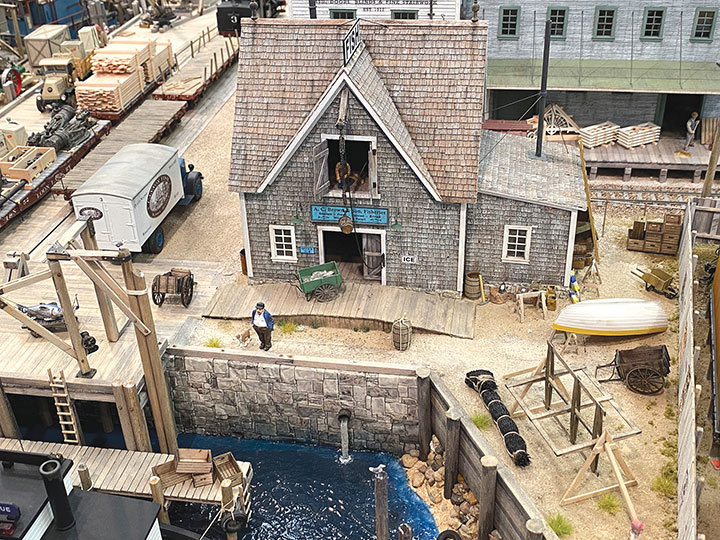
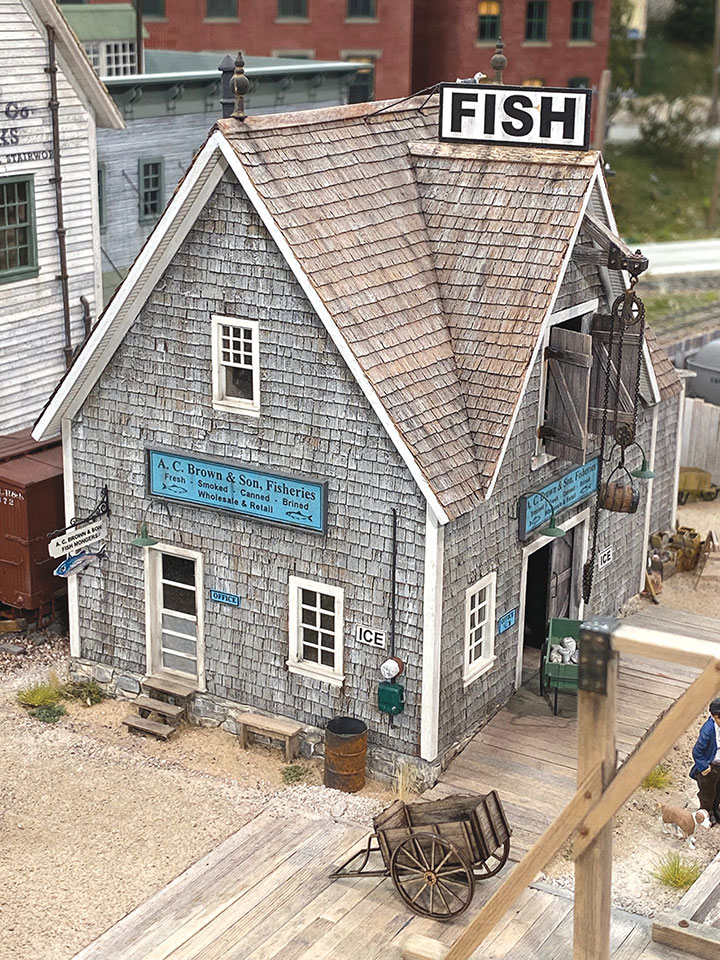
The Fishery is surrounded by an array of clutter; pushcarts, a fishnet drying rack, net floats, an overturned dinghy and lots of empty, wooden crates. The excellent little fish crates are available from Train Troll, and they find a lot of useful applications around the layout. The pushcart is also a Train Troll item. The cart is marketed as HO scale but is more than large enough to pass for S scale. A small, scratchbuilt jib crane was installed to lift the catch from the cannery tender to the dock and then onto pushcarts for movement into the building for processing. The blue and white van next to the cannery is a modified Hartoy vehicle. I found the “Cannon Fish” logo on the internet, printed it on decal paper and applied it to the side of the truck.
To the casual eye, the waterfront looks complete, but that empty lot at the left end of the scene is just begging for some attention. It’s just a matter of time before a construction crew moves in, boots out the Crab Shack squatters and gets something started.